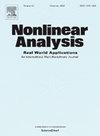时间周期Jordan-Moore-Gibson-Thompson方程的适定性
IF 1.8
3区 数学
Q1 MATHEMATICS, APPLIED
引用次数: 0
摘要
基于非线性超声在连续波激励下的应用,研究了时间周期性条件下三阶拟线性偏微分方程Jordan-Moore-Gibson-Thompson (JMGT)方程。在这里,三阶时间导数的系数就是所谓的松弛时间,彻底理解松弛时间消失的极限行为对于将这些JMGT方程与非线性声学中的经典二阶模型联系起来至关重要。与同时很好地理解JMGT的初值问题相比,由于时间规律性的丧失,周期设置带来了实质性的挑战。然而,分析仍然需要对解的大小进行点(在空间和时间上)控制,以保持稳定性或等效地避免二次导数系数的退化。在实际相关的混合边界条件下,我们提供了在存在和不存在梯度非线性的情况下,与建模非累积非线性效应相关的完整的适定性分析。因此,源到状态映射是定义良好的,此外,我们还表明它是Lipschitz连续可微的,这个结果对于声学非线性层析成像等逆问题的应用是有用的。为周期JMGT方程的适定性分析所导出的能量界也允许充分证明松弛时间消失的奇异极限。本文章由计算机程序翻译,如有差异,请以英文原文为准。
Well-posedness of the time-periodic Jordan–Moore–Gibson–Thompson equation
Motivated by applications of nonlinear ultrasonics under continuous wave excitation, we study the Jordan–Moore–Gibson–Thompson (JMGT) equation – a third order in time quasilinear PDE – under time periodicity conditions. Here the coefficient of the third order time derivative is the so-called relaxation time and a thorough understanding of the limiting behavior for vanishing relaxation time is essential to link these JMGT equations to classical second order models in nonlinear acoustics,
As compared to the meanwhile well understood initial value problem for JMGT, the periodic setting poses substantial challenges due to a loss of temporal regularity, while the analysis still requires a pointwise (in space and time) control on the magnitude of solutions in order to maintain stability or equivalently, to avoid degeneracy of the second time derivative coefficient.
We provide a full well-posedness analysis both in the presence and absence of gradient nonlinearity, as relevant for modeling non-cumulative nonlinear effects, under practically relevant mixed boundary conditions. The source-to-state map is thus well-defined and in addition we show it to be Lipschitz continuously differentiable, a result that is useful for inverse problems applications such as acoustic nonlinearity tomography. The energy bounds derived for the well-posedness analysis of periodic JMGT equations also allow to fully justify the singular limit for vanishing relaxation time.
求助全文
通过发布文献求助,成功后即可免费获取论文全文。
去求助
来源期刊
CiteScore
3.80
自引率
5.00%
发文量
176
审稿时长
59 days
期刊介绍:
Nonlinear Analysis: Real World Applications welcomes all research articles of the highest quality with special emphasis on applying techniques of nonlinear analysis to model and to treat nonlinear phenomena with which nature confronts us. Coverage of applications includes any branch of science and technology such as solid and fluid mechanics, material science, mathematical biology and chemistry, control theory, and inverse problems.
The aim of Nonlinear Analysis: Real World Applications is to publish articles which are predominantly devoted to employing methods and techniques from analysis, including partial differential equations, functional analysis, dynamical systems and evolution equations, calculus of variations, and bifurcations theory.

 求助内容:
求助内容: 应助结果提醒方式:
应助结果提醒方式:


